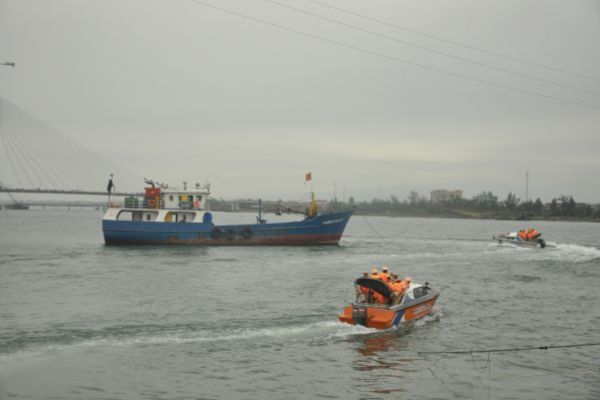When Stopping Waterway Vehicles for Inspection at Night, What Signals Must the Waterway Police Perform?
When stopping waterway vehicles for inspection at night, what commands must waterway police follow?
Based on the provisions in Clause 3, Article 8 of Circular 36/2023/TT-BCA as follows:
Stopping vehicles for inspection
...
3. Command to stop the vehicle
When stopping a vehicle for inspection, the police must consider the traffic density, the situation, and the characteristics of the traffic route to ensure safety and normal circulation of other vehicles and act as follows:
a) During the day, direct the "K" flag towards the vehicle to be inspected, wave it three times vertically from top to bottom, and simultaneously sound a long beep, a short beep, and a long beep;
b) At night, direct the signaling light towards the vehicle to be inspected, flash one long light, one short light, and one long light, and simultaneously sound a long beep, a short beep, and a long beep;
c) In addition to the above commands, loudspeakers can be used to instruct the vehicle to stop or reduce speed for inspection.
Thus, based on the above regulations, waterway police, when stopping a waterway vehicle for inspection at night, must direct the signaling light towards the vehicle to be inspected, flash one long light, one short light, and one long light, and simultaneously sound a long beep, a short beep, and a long beep.
In addition to the above commands, waterway police can use loudspeakers to instruct the vehicle to stop or reduce speed for inspection.

When stopping waterway vehicles for inspection at night, what commands must waterway police follow? (Image from the Internet)
What is the procedure for conducting inspections of waterway traffic vehicles?
Based on the provisions in Clause 1, Article 9 of Circular 36/2023/TT-BCA, the procedure for conducting inspections of waterway traffic vehicles is as follows:
- After signaling to stop the vehicle, officers from the patrol and inspection team guide the vehicle to reach the shore, dock (if inspected at the Station), or align with the patrol and inspection vessel.
In cases where the location for stopping the vehicle has deep water, complex terrain, narrow channels, shallow areas, or difficulties in stopping the vehicle, inform the vehicle operator to reduce speed and maneuver the patrol and inspection vessel to align with the vehicle to be inspected;
- The team leader and the assigned members board the vehicle, meet the vehicle owner or operator; depending on the specific case, the team leader or assigned member can perform a salutation according to the People's Public Security Ordinance or verbally greet, introduce rank, name, position, and work unit; announce the reason and content of the inspection and request compliance; conduct the inspection according to regulations;
- Content and methods of inspection on the vehicle:
+ Inspect documents of the vehicle, crew members, and persons on the vehicle; inspect goods carried on the vehicle, documents of the goods, and other relevant documents as required (hereafter referred to as documents). When inspecting documents, they must be compared with the actual situation and the legality of the documents must be determined;
+ Inspect the technical safety and environmental protection conditions of the vehicle: inspection is done by visual observation, comparing the actual situation with the vehicle's documents or by technical equipment from inside to outside, from top to bottom. When necessary, check the database or request specialized agencies for inspection;
+ Inspect transportation safety: The draft of the vehicle compared to the safe draft mark; types, quantities, sizes, dimensions of goods, objects, the number of actual passengers compared to the vehicle's carrying capacity, and safety measures in transportation activities;
+ Inspect other relevant contents as required by law;
When inspecting, the representative of the vehicle owner or crew members, and the vehicle operator must be present. In case of their absence, the inspection must have the presence of the local government's representative or at least one witness.
After national databases and specialized databases are connected to the identity and electronic authentication system, confirming the validity and usage status of the above-mentioned documents (retained, revoked, confiscated, lost), the inspection through checking and comparing information from these documents in the electronic identification account level 2 has the same value as directly checking the paper documents.
- In cases where the vehicle operator presents documents, check and compare those documents directly.
In cases where the vehicle operator provides information of the documents in the electronic identification account, verify and compare the information in the electronic identification account.
During the inspection process, if the electronic identification account is suspected of being forged or if the organization or individual is found violating actions requiring the retention, revocation, confiscation of documents, request the organization or individual to present those documents for handling according to law.
- In cases of inspecting vehicles transporting flammable, explosive substances, toxic substances, or other dangerous goods, safety measures must be taken to move the vehicle away from residential areas or to less populated areas for inspection; if necessary, request specialized agencies to participate in the inspection activities.
In which cases are waterway police authorized to stop vehicles?
Based on the provisions in Clause 1, Article 8 of Circular 36/2023/TT-BCA, waterway police are authorized to stop vehicles for inspection in 04 cases when performing patrol and control duties according to the plan:
- Directly detect or through technical and professional devices recognize signs of legal violations;
- Implement directives, patrol plans, control plans, and work schemes approved by the Brigade Chief; Chief of Traffic Police Department; Chief of District-level Police;
- Have a written request to stop the vehicle by the Head, Deputy Head of the Investigation Agencies at all levels, and related functional agencies for inspection in service of national security protection, social order, and safety assurance tasks;
- Receive reports and denunciations about legal violations related to people and vehicles involved in traffic.
LawNet